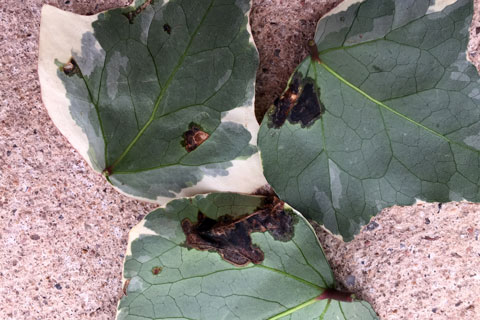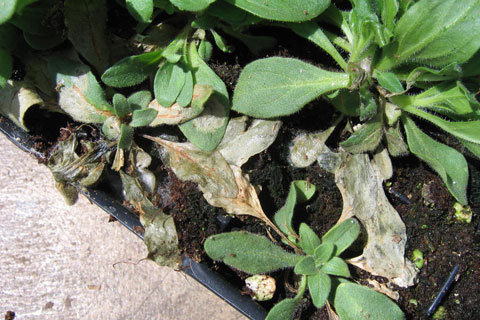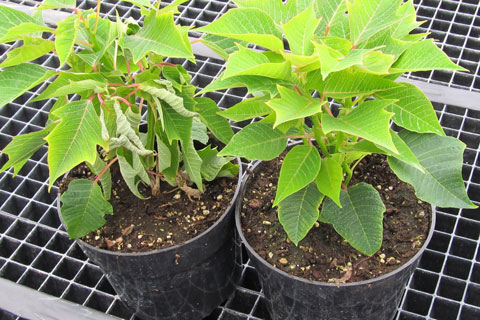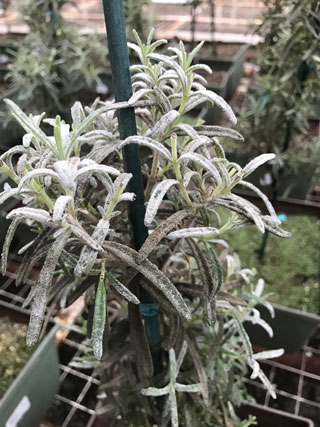8/1/2023
Biofungicides: What to Consider
A.R. Chase
We’re hearing more today about biopesticides than ever before—especially if you’re growing organically. But what if you aren’t trying to grow crops with biopesticides, exclusively? They can definitely be used in a “conventional” production setting, as well; you just have to be mindful that the conventional products don’t interfere with the biopesticides.
 Pictured: Xanthomonas on Hedera (ivy).
Pictured: Xanthomonas on Hedera (ivy).
Most biopesticides are OMRI-listed and can include biological agents like bacteria, fungi and predatory mites and insects. They can also be extracts from a biological organism such as a plant.
You should be aware of some considerations before trying biopesticides in your operation. It might be simpler to convert completely to biopesticides, but it’s rarely practical due to limitations in controlling a wide array of diseases. There are some facts you need to know to make the most successful use of any pesticide—biological or conventional.
Myths & misconceptions
Here are a few of the statements I’ve heard from a variety of growers, researchers and manufacturer representatives regarding biopesticides (especially those classified as true biologicals):
• Biopesticides don’t work as well as synthetic or conventional products.
• Biopesticides don’t have a good shelf life.
• Biopesticides aren’t compatible with synthetic or conventional products.
• Applying biopesticides once is enough for the life of the crop.
• We don’t know what biopesticides are doing. They’re magic.
• Biopesticides are never phytotoxic and are inherently safe for the environment, plants and humans.
 Pictured: Sclerotinia blight on petunia.
Pictured: Sclerotinia blight on petunia.
Each of these statements is wrong, at least as applied to some of the biopesticides registered today.
In contrast, the following characteristics are true for many biopesticides, including:
• Some biologicals or biopesticides must be used before the pest pressure arrives (at seedling, at planting in plug trays).
• Biopesticides should be used following (or sometimes with) chemical fungicides.
• Under high disease pressure, biopesticides may not perform well.
• Many things affect efficacy of biopesticides, including fertilizer, host plant, pathogens and even pathogen species.
• Being a better grower makes using biologicals (and really all) fungicides and bactericides more likely to succeed.
Although some products are biologicals, biopesticides and organics—not all biopesticides are biological and not all organic products are biopesticides. Biopesticides that aren’t biological control agents (BCAs) act more like synthetic products, making them simpler to use in many cases. These products are typically a combination of a variety of chemicals they (biological agents) make in culture or are extracted from them (like plant extracts).
 Pictured: Pythium root rot (on left).
Pictured: Pythium root rot (on left).
Biopesticides can be simple, but are more likely to provide a variety of direct and indirect effects. An example of direct effects would be lipopolysaccharides that destroy bacterial and fungal cells, for example Bacillus.
Indirect effects are those that such products trigger in the host—often referred to as SAR (systemic acquired resistance) factors. Trichoderma, Bacillus and some plant extracts have been proven to trigger plant defense responses.
One of the best examples of how much our knowledge has improved over the past 20 years is the understanding of T-22 (one of the BCAs in RootShield Plus). Here’s a summary of the ways that researchers (often at universities here and internationally) have discovered they work. This particular summary was prepared by BioWorks Inc:
• Excludes pathogens: RootShield Plus takes up space in the rhizosphere and crowds out pathogens. It not only overtakes that space, it eats nutrients as well, causing pathogens to starve.
• Shields roots: Not only does RootShield Plus grow on the roots, it shields them from pathogens. It acts as a barrier that pathogens cannot get through.
• Hunts and eats pathogenic fungi: RootShield Plus seeks out, attacks and eats fungal pathogens.
• Antagonizes pathogens: RootShield Plus releases anti-pathogen substances, creating a zone that is inhospitable to pathogens.
• Induces host resistance: RootShield Plus, with its presence in the rhizosphere, signals the plant to accumulate defensive compounds, which gives the plant a better defense response in subsequent encounters with pathogens.
What factors affect the use of biopesticides?
The answer is: exactly everything that affects how conventional products work, including: timing, rate and interval, inoculum pressure and crop, tank-mixing or alternation with conventional/synthetic fungicides, the potting medium, irrigation method and fertility regime, and finally, even the exact species of the pathogen causing the disease. This list is the same for biopesticides since what’s being described is how the course of a plant disease is affected.
 Pictured: Powdery mildew on rosemary.
Pictured: Powdery mildew on rosemary.
Dr. Mary Hausbeck and her team at Michigan State University performed extensive research with a few biologicals and a few conventional fungicides. They tested the ability of each product to control several species of Pythium on two crops (snapdragon and geranium). The best biological OR fungicide for one species of Pythium on geranium wasn’t the same as the best for another species of Pythium on the same crop or even the same Pythium species on another crop. Consistency wasn’t better for the conventional fungicides than for the biologicals. So the picture of choosing what biological or conventional products work best is based on what your crop(s) is and what the exact cause of the disease might be. Unfortunately, however, we don’t know the exact product for a specific situation that would perform the best.
If the biopesticide is a biological control agent and alive, there are factors that must be considered to ensure their effective use. First, you must realize that everything that affects the crop or the plant pathogen can affect another living organism—the BCA. This includes water level, salinity, potting medium characteristics and, of course, conventional fungicides or bactericides. GT
This article was originally published in the first edition of our Biosolutions Guide, which came out with the June issue of GrowerTalks.
A.R. Chase is with Chase Agricultural Consulting.